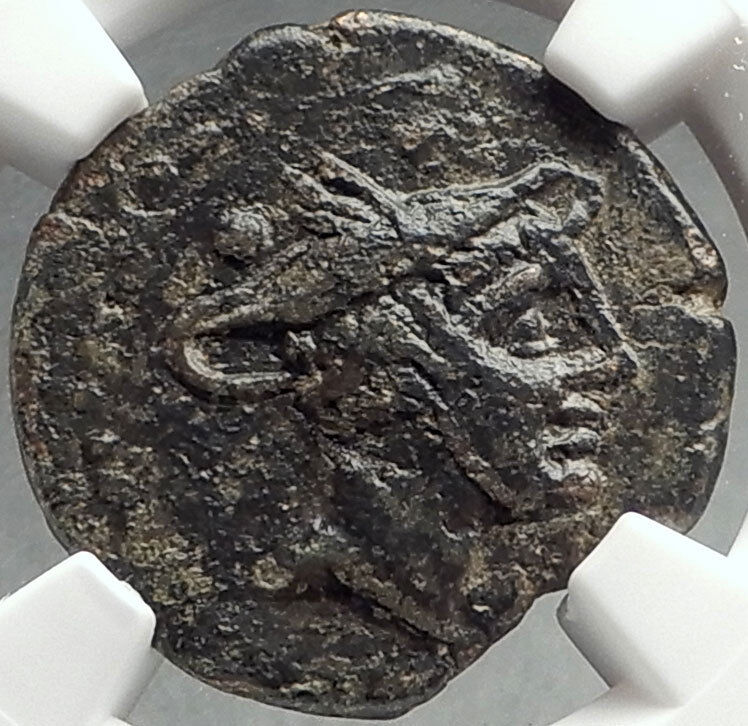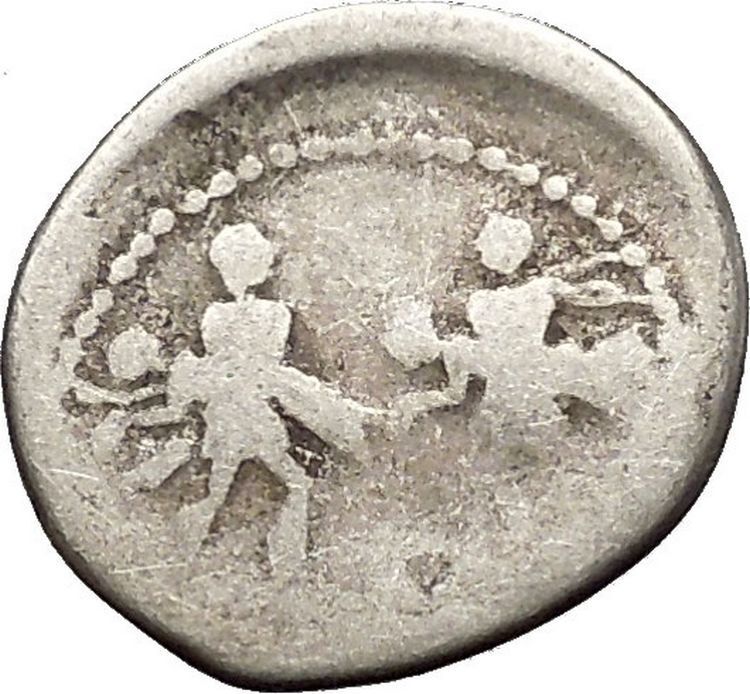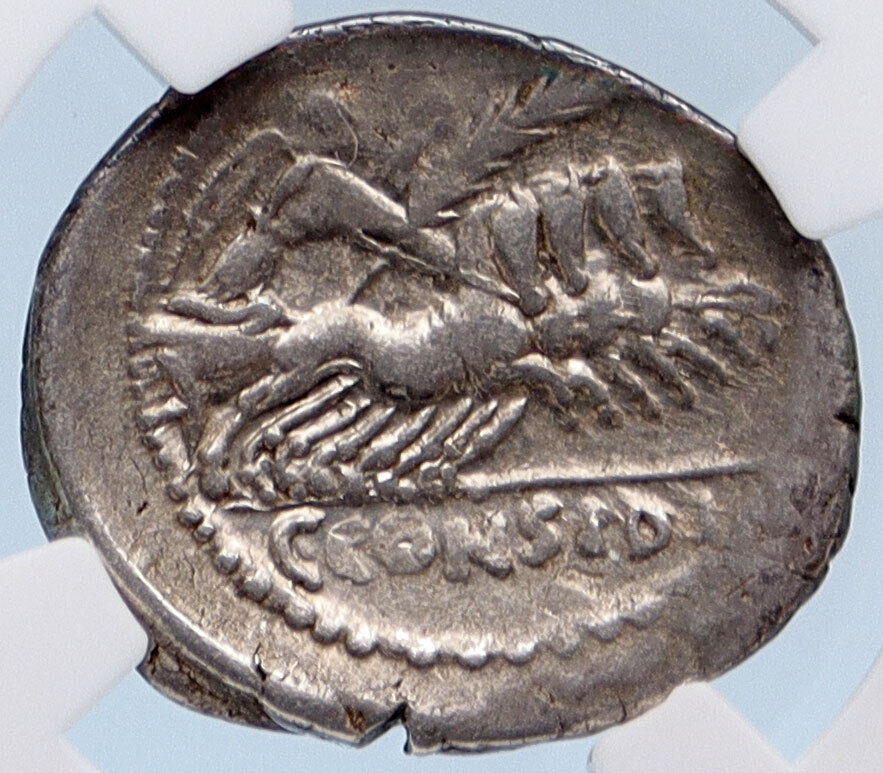|
Roman Republic Q. Caecilius Metellus Pius Scipio
Imperator: 47-46 B.C.
Silver Denarius 17mm (3.63 grams) Utica mint, Struck circa 47- Spring 46 B.C.
Reference: Caecilia 51; B.M.C., Africa 8; Syd. 1050; Craw. 460/4
Rarity: R3 | Certification: NGC Ancients VF 4375823-111
The Lion-headed Genius of Africa (Sekhet) standing facing, holding the ankh, G . T . A (Genius Tutelaris Africae) above, Q . METEL . PIVS on right, SCIPIO IMP on left.
Victory standing left, holding caduceus and round shield, P . CRASSVS IVN behind, LEG . PRO . PR in front.
After Pompey’s defeat by Caesar at Pharsalus (Greece) in 48 and then his subsequent murder, his followers gathered in Africa and several of them struck coinage on their own account. One of them was Metellus Scipio who produced five issues; one alone, three others with the legate Junianus as here and the fifth with M. Eppius. It is uncertain whether his use of IMP on all of them indicated that he had actually been hailed as imperator by his troops or was meant to justify his coinage.
It was Metellus Scipio who disclosed to Cicero the Cataline conspiracy, was consul with Pompey in 52, and governor of Selucia in 49. He commanded the center line of Pompey’s army at Pharsalus, after which he fled to Africa and formed an alliance with Juba, King of Numidia.
Metellus Scipio was a Cornelius Scipio who was adopted into the Caecilius clan and was therefore related to Scipio Africanus who defeated Hannibal at Zama in 202 and won the Second Punic War. He appeared to believe that the cognomen Scipio (scepter) held some power. All of his coinage, filled with symbols of hoped-for victory, is pathetically true to its author’s belief in the ‘felix et invictum Scipionum nomen’ (per Seutonius: ‘the good luck and invincibility of the name Scipio’). This belief was overcome by the greater felicitas of Caesar, who defeated him at Thapsus (Tunisia) in B.C. 46.
You are bidding on the exact item pictured, provided with a Certificate of Authenticity and Lifetime Guarantee of Authenticity.
Quintus Caecilius Metellus Pius Scipio Nasica (c. 100/98 BC – 46 BC), in modern scholarship often as Metellus Scipio, was a Roman consul and military commander in the Late Republic. During the civil war between Julius Caesar and the senatorial faction led by Pompeius Magnus (“Pompey the Great”), he remained a staunch optimate. He led troops against Caesar’s forces, mainly in the battles of Pharsalus and Thapsus, where he was defeated. He later committed suicide. Ronald Syme called him “the last Scipio of any consequence in Roman history.”
Metellus Scipio was born Publius Cornelius Scipio Nasica. His grandfather was the P. Cornelius Scipio Nasica Serapio who was consul in 111 BC; his father married Licinia Crassa, daughter of the L. Licinius Crassus who was consul in 95 BC. The father died not long after his praetorship (c. 93 BC), and was survived by two sons and two daughters. The brother was adopted by their grandfather Crassus, but left little mark on history.
Publius Scipio, as he was referred to in contemporary sources early in his life, was adopted in adulthood through the testament of Quintus Caecilius Metellus Pius, consul in 80 BC and pontifex maximus. He retained his patrician status: “Scipio’s ancestry,” notes Syme, “was unmatched for splendour.” As Jerzy Linderski has shown at length, this legal process constitutes adoption only in a loose sense; Scipio becomes a Caecilius Metellus in name while inheriting the estate of Metellus Pius, but was never his “son” while the pontifex maximus was alive. He was called “Metellus Scipio” but also sometimes just “Scipio” even after his adoption. The official form of his name as evidenced in a decree of the senate was “Q. Caecilius Q. f. Fab. Metellus Scipio.”
Scipio married Aemilia Lepida, daughter of Mamercus Aemilius Lepidus Livianus (consul 77 BC), but was not without rival in the match. The virginal Cato had also wanted to marry Aemilia and lost out in the seduction:
| “ |
When [Cato] thought that he was old enough to marry,— and up to that time he had consorted with no woman,— he engaged himself to Lepida, who had formerly been betrothed to Metellus Scipio, but was now free, since Scipio had rejected her and the betrothal had been broken. However, before the marriage Scipio changed his mind again, and by dint of every effort got the maid. Cato was greatly exasperated and inflamed by this, and attempted to go to law about it; but his friends prevented this, and so, in his rage and youthful fervour, he betook himself to iambic verse, and heaped much scornful abuse upon Scipio … . |
” |
The couple had one son, a Metellus Scipio who seems to have died when he was only 18. Another son may have been born around 70, or a son may have been adopted. The couple’s much more famous daughter was born around that time as well. Scipio first married off the celebrated Cornelia Metella to Publius Crassus, the son of Marcus Licinius Crassus. After Publius’s premature death at Carrhae, Scipio decided to succeed Caesar as the father-in-law of Pompeius, who was at least thirty years older than Cornelia. The marriage is one of the acts by which Pompeius severed his alliance to Caesar and declared himself the champion of the optimates. He and Scipio were consuls together in 52.
Cicero names “P. Scipio” among the young nobiles on his defense team when Roscius of Ameria [sic] was prosecuted in 80 BC. He is placed in the company of M. Messalla and Metellus Celer, both future consuls.
Metellus Scipio has been listed as plebstribune of the in 59, but his patrician status argues against his holding the office. It is possible that Scipio’s ‘adoption’ into a plebeian gens may have qualified him for a tribunate on a technicality.[citation needed] He was possibly curule aedile in 57 BC, when he presented funeral games in honor of his adopted father’s death six years earlier. He was praetor, most likely in 55 BC, during the second joint consulship of Pompeius and Marcus Crassus.
In 53 BC, he was interrex with M. Valerius Messalla. He became consul with Pompeius in 52 BC, the year he arranged the marriage of his newly widowed daughter to him.
Indisputably aristocratic and conservative, Metellus Scipio had been at least symbolically a counterweight to the power of the so-called triumvirate before the death of Crassus in 53. “Opportune deaths,” notes Syme, “had enhanced his value, none remaining now of the Metellan consuls.”
He is known to have been a member of the College of Pontiffs by 57 BC, and was probably nominated upon the death of his adoptive father in 63 and subsequently elected.
Senate of the Roman Republic
The Senate’s ultimate authority derived from the esteem and prestige of the Senate.This esteem and prestige was based on both precedent and custom, as well as the high calibre and prestige of the Senators.The Senate passed decrees, which were called senatus consulta. This was officially “advice” from the Senate to a magistrate. In practice, however, these were usually obeyed by the magistrates.The focus of the Roman Senate was directed towards foreign policy.Though it technically had no official role in the management of military conflict, the Senate ultimately was the force that oversaw such affairs.
Legislative Assemblies
The legal status of Roman citizenship was strictly limited and was a vital prerequisite to possessing many important legal rights such as the right to trial and appeal, to marry, to vote, to hold office, to enter binding contracts, and to special tax exemptions. Not all those rights were available to every citizen – women could be citizens, but were denied the rights to vote or hold elected office.
An adult male citizen with the full complement of legal and political rights was called “optimo jure.” The optimo jure elected their assemblies, whereupon the assemblies elected magistrates, enacted legislation, presided over trials in capital cases, declared war and peace, and forged or dissolved treaties.There were two types of legislative assemblies. The first was the comitia (“committees”),which were assemblies of all optimo jure. The second was the concilia (“councils”), which were assemblies of specific groups of optimo jure.
Assembly of the Centuries
Citizens were organized on the basis of centuries and tribes. The centuries and the tribes would each gather into their own assemblies. The Comitia Centuriata (“Century Assembly”) was the assembly of the centuries. The president of the Comitia Centuriata was usually a consul.The centuries would vote, one at a time, until a measure received support from a majority of the centuries. The Comitia Centuriata would elect magistrates who had imperium powers (consuls and praetors). It also elected censors. Only the Comitia Centuriata could declare war, and ratify the results of a census. It also served as the highest court of appeal in certain judicial cases.Assembly of the Tribes
The assembly of the tribes, the Comitia Tributa, was presided over by a consul, and was composed of 35 tribes. The tribes were not ethnic or kinship groups, but rather geographical subdivisions.The order that the thirty-five tribes would vote in was selected randomly by lot. Once a measure received support from a majority of the tribes, the voting would end. While it did not pass many laws, the Comitia Tributa did elect quaestors, curule aediles, and military tribunes.
Plebeian Council
The Plebeian Council was an assembly of plebeians, the non-patrician citizens of Rome, who would gather into their respective tribes. They elected their own officers, plebeian tribunes and plebeian aediles. Usually a plebeian tribune would preside over the assembly. This assembly passed most laws, and could also act as a court of appeal. Since it was organised on the basis of the tribes, its rules and procedures were nearly identical to those of the Comitia Tributa.
Pompey, Crassus and the Catilinarian Conspiracy
In 77 BC, the senate sent one of Sulla’s former lieutenants, Gnaeus Pompeius Magnus (“Pompey the Great”), to put down an uprising in Spain. By 71 BC, Pompey returned to Rome after having completed his mission. Around the same time, another of Sulla’s former lieutenants, Marcus Licinius Crassus, had just put down the Spartacus led gladiator/slave revolt in Italy. Upon their return, Pompey and Crassus found the populares party fiercely attacking Sulla’s constitution. They attempted to forge an agreement with the populares party. If both Pompey and Crassus were elected consul in 70 BC, they would dismantle the more obnoxious components of Sulla’s constitution. The two were soon elected, and quickly dismantled most of Sulla’s constitution.
Around 66 BC, a movement to use constitutional, or at least peaceful, means to address the plight of various classes began. After several failures, the movement’s leaders decided to use any means that were necessary to accomplish their goals. The movement coalesced under an aristocrat named Lucius Sergius Catilina. The movement was based in the town of Faesulae, which was a natural hotbed of agrarian agitation. The rural malcontents were to advance on Rome, and be aided by an uprising within the city. After assassinating the consuls and most of the senators, Catiline would be free to enact his reforms. The conspiracy was set in motion in 63 BC. The consul for the year, Marcus Tullius Cicero, intercepted messages that Catiline had sent in an attempt to recruit more members. As a result, the top conspirators in Rome (including at least one former consul) were executed by authorisation (of dubious constitutionality) of the senate, and the planned uprising was disrupted. Cicero then sent an army, which cut Catiline’s forces to pieces.
The most important result of the Catilinarian conspiracy was that the populares party became discredited. The prior 70 years had witnessed a gradual erosion in senatorial powers. The violent nature of the conspiracy, in conjunction with the senate’s skill in disrupting it, did a great deal to repair the senate’s image.
First Triumvirate
In 62 BC, Pompey returned victorious from Asia. The Senate, elated by its successes against Catiline, refused to ratify the arrangements that Pompey had made. Pompey, in effect, became powerless. Thus, when Julius Caesar returned from a governorship in Spain in 61 BC, he found it easy to make an arrangement with Pompey. Caesar and Pompey, along with Crassus, established a private agreement, now known as the First Triumvirate. Under the agreement, Pompey’s arrangements would be ratified. Caesar would be elected consul in 59 BC, and would then serve as governor of Gaul for five years. Crassus was promised a future consulship.
Caesar became consul in 59 BC. His colleague, Marcus Calpurnius Bibulus, was an extreme aristocrat. Caesar submitted the laws that he had promised Pompey to the assemblies. Bibulus attempted to obstruct the enactment of these laws, and so Caesar used violent means to ensure their passage. Caesar was then made governor of three provinces. He facilitated the election of the former patrician Publius Clodius Pulcher to the tribunate for 58 BC. Clodius set about depriving Caesar’s senatorial enemies of two of their more obstinate leaders in Cato and Cicero. Clodius was a bitter opponent of Cicero because Cicero had testified against him in a sacrilege case. Clodius attempted to try Cicero for executing citizens without a trial during the Catiline conspiracy, resulting in Cicero going into self-imposed exile and his house in Rome being burnt down. Clodius also passed a bill that forced Cato to lead the invasion of Cyprus which would keep him away from Rome for some years. Clodius also passed a bill that gave the populace a free grain dole, which had previously just been subsidised.
The end of the First Triumvirate
Clodius formed armed gangs that terrorised the city and eventually began to attack Pompey’s followers, who in response funded counter-gangs formed by Titus Annius Milo. The political alliance of the triumvirate was crumbling. Domitius Ahenobarbus ran for the consulship in 55 BC promising to take Caesar’s command from him. Eventually, the triumvirate was renewed at Lucca. Pompey and Crassus were promised the consulship in 55 BC, and Caesar’s term as governor was extended for five years. Crassus led an ill-fated expedition with legions led by his son, Caesar’s lieutenant, against the Kingdom of Parthia. This resulted in his defeat and death at the Battle of Carrhae. Finally, Pompey’s wife, Julia, who was Caesar’s daughter, died in childbirth. This event severed the last remaining bond between Pompey and Caesar.
Beginning in the summer of 54 BC, a wave of political corruption and violence swept Rome. This chaos reached a climax in January of 52 BC, when Clodius was murdered in a gang war by Milo. On 1 January 49 BC, an agent of Caesar presented an ultimatum to the senate. The ultimatum was rejected, and the senate then passed a resolution which declared that if Caesar did not lay down his arms by July of that year, he would be considered an enemy of the Republic. On 7 January of 49 BC, the senate passed a senatus consultum ultimum, which vested Pompey with dictatorial powers. Pompey’s army, however, was composed largely of untested conscripts. On 10 January, Caesar crossed the Rubicon with his veteran army (in violation of Roman laws) and marched towards Rome. Caesar’s rapid advance forced Pompey, the consuls and the Senate to abandon Rome for Greece. Caesar entered the city unopposed.
|













